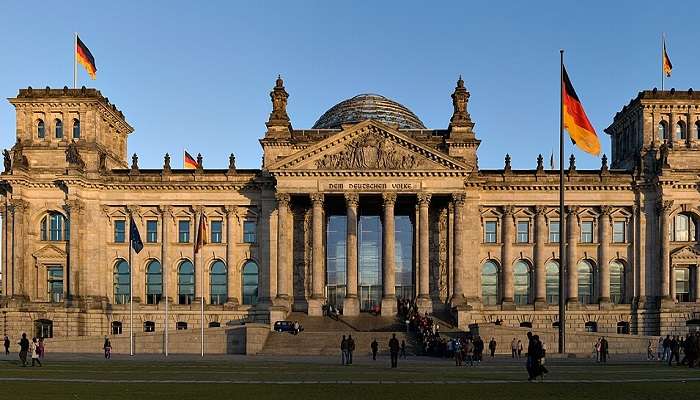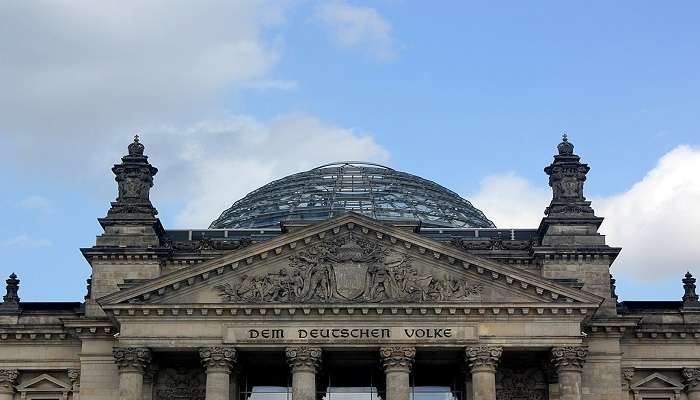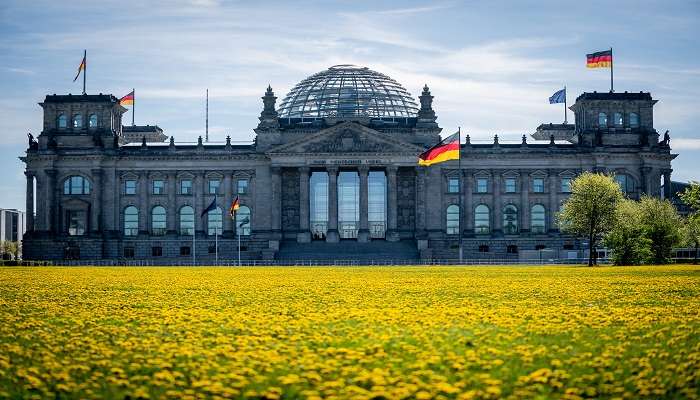Discover The Architectural Gem Of Reichstag Building In Berlin

The Reichstag Building in Berlin stands as a powerful symbol of German democracy and resilience. This iconic structure, with its imposing neoclassical facade and gleaming glass dome, has witnessed over a century of tumultuous history. From its construction in 1894 to house the Imperial Diet, through the infamous fire of 1933 to its rebirth as the seat of the German Parliament after reunification, the Reichstag has endured as a testament to the nation’s spirit. Today, it serves not only as the home of the Bundestag but also as a popular tourist attraction, offering visitors a unique blend of political significance and architectural marvel. The Reichstag Building continues to captivate both locals and tourists alike.
About Reichstag Building

The Reichstag Building in Berlin is a historical building, but at the same time, it is the building that houses the German Bundestag. It was built by architect Paul Wallot, and the construction took place between 1884 and 1894. The building that you see today has stood through German history and has seen the Reichstag fire in 1933 and the damage it received during the Second World War.
The Reichstag building is situated in Berlin, Germany, and after the reunification of Germany, the building underwent reconstruction by the British architect Norman Foster. Among the main distinctive features of the renovated building is the glass dome, which provides a unique opportunity to enjoy the view of Berlin in its entirety. Nowadays, the Reichstag building remains one of the major landmarks of Germany’s troubled history and is a popular tourist attraction for millions of tourists.
Also Read: Museums In Frankfurt
History Of Reichstag Building

Construction of the Reichstag building started soon after the unification of Germany in 1871, and the winning design was that of Paul Wallot in a competition held in 1882, which was Neo-Baroque style. Construction of the building started in 1884 with the laying of the foundation stone by Wilhelm I of Germany, although he did not see the completion of the building in 1894. Wilhelm II, who was an anti-parliamentarian, was also against the ‘Dem Deutschen Volke’, which was inscribed in 1916.
The Reichstag was also the site of important events in the history of Germany, such as the proclamation of the Weimar Republic by Philipp Scheidemann in 1918 or the bloody suppression of the Spartakist uprising known as the Reichstag Bloodbath in 1920. During the Second World War, as a symbol of the Nazi party, the building was burned in 1933, which led to the ‘Reichstag Fire Decree’ and it was used as a target of war. After the war, it lay in ruins and was rebuilt from 1961 to 1971 with the simplification of the structure.
The Reichstag building was instrumental in the German reunification process as the signing was done here on the 3rd of October, 1990. The construction of the Bundestag started in 1961, but it was only in 1991 that it was moved back to Berlin. Later, in 1999, the building was renovated by Norman Foster, who designed a new glass dome. Today, it is one of the symbols of democracy and one of the most visited places in the country.
Architecture Of Reichstag Building

The Reichstag Building is a historical building located in Berlin, and it features classical and modern architecture. It was designed by Paul Wallot and was completed in 1894; it is in Neo-Renaissance style with a large exterior and a central dome. The building was also destroyed during the Second World War but was reconstructed later.
In the 1990s, the building was redesigned by the British architect Sir Norman Foster, and a new glass roof was installed, which means ‘transparency’ and ‘democracy’. The glass dome at the top of the building enables sunlight to penetrate the interior of the building and, at the same time, offers a view of the city of Berlin. Nowadays, the Reichstag is the home of the German Bundestag; it symbolises Germany’s past and its commitment to a better future.
Related Post: Hindu Temples In Germany
Things To Do Inside Reichstag Building

The Reichstag Building in Berlin is a historic and architectural marvel that offers a variety of activities for visitors. Here are some things you can do inside the Reichstag Building:
Take an Audioguide Tour: Grab an audioguide from the roof terrace to learn about the history of the Reichstag, the German Bundestag, the Parliament, and the surrounding area. This self-guided tour provides insightful information as you explore the building.
See the Soviet Graffiti: The graffiti left by Soviet soldiers in 1945 has been preserved and can be seen today. These markings serve as a poignant reminder of the building’s turbulent history during World War II.
Appreciate the Architecture: Even if you don’t typically have much of an interest in architecture, it’s hard not to appreciate this building and its natural lighting. The combination of historical and modern design elements makes it a unique structure.
Check the Views: Of course, the main reason for visiting the Reichstag is the views it offers. From the glass dome, you can enjoy panoramic views of Berlin, making it a must-see attraction.
Listen to a Plenary Session: If you’re lucky enough to speak German, you can easily listen to Bundestag’s plenary sessions if one is happening during your visit. This gives you a firsthand experience of German parliamentary proceedings.
Entrance Fees And Timings

The Reichstag Building in Berlin is free to visit, but you must register in advance. It is open daily from 8 AM to midnight, with the last entry at 10 PM. The building is closed on December 24th and closes early on New Year’s Eve.
The glass dome will be closed for maintenance on specific dates in 2024: April 15–19, July 8–19, July 22–26, October 21–25, and October 28–November 1, though the roof terrace remains accessible during these periods.
Related Post: Berlin Street Food
How To Reach?

Depending on your preferred mode of transportation, you can reach the Reichstag Building, one of Berlin’s most significant landmarks, in several convenient options. The options are as follows:
By Bus
Bus Number 100 is one of the most beautiful routes that one can take to get to the Reichstag Building. This bus route is very much used by tourists because there are many places of interest in Berlin along this route. To get to the Reichstag, one has to take the bus and alight at the Reichstag/Bundestag bus stop. From there, it is only about a 3-minute walk to the building, and the walk is very scenic.
By Train
If you decide to travel by train, then it’s better to take the S-Bahn in Berlin, namely S1 and S26. These trains offer one with an easy time when it comes to the movement within the city. To get to the Reichstag Building, one has to get off at the Brandenburger Tor station. The Reichstag is only 9 9-minute walk away from this station, and you will be able to walk through the historical area of the city.
By Metro (U-Bahn)
The metro is another great way to get to the Reichstag Building, and it is also well-connected. U-Bahn transportation is available in Berlin, and it offers many lines to be selected from, such as U2 (Red Line), U5 (Brown Line), or U6 (Purple Line). To get to the Reichstag, one should alight at U Bundestag station. It is only a 4-minute walk from this stop to the building, and so the metro is a very convenient and fast way for the visitors.
You May Also Like To Read: Haunted Places In Munich
This architectural wonder has seen the rise and fall of history from its burning to rising again. Today, the Reichstag building houses the German Parliament and is not just a symbol of the country’s leadership but also a symbol of democracy. Its glass top, which provides a view of the city of Berlin, allows the visitors to contemplate the nation’s journey and the future ahead of it. Ready to experience this iconic landmark firsthand? Don’t miss the opportunity to explore the Reichstag Building and immerse yourself in Berlin’s rich history. Book your trip to Berlin today and witness the heartbeat of German democracy in person!
For our editorial codes of conduct and copyright disclaimer, please click here.
Cover Image Credit : Jürgen Matern for Wikimedia Commons
Frequently Asked Questions About Reichstag Building
What are some facts about the Reichstag building?
The Reichstag, constructed between 1884 and 1894, is the seat of the German Bundestag. It suffered severe damage in 1933 and during WWII but was restored and now features a distinctive glass dome symbolising transparency.
What does it say about the Reichstag building?
The Reichstag building bears the inscription Dem Deutschen Volke, which translates to To the German People. This phrase is prominently displayed above the main entrance, signifying the building's dedication to the German populace.
Why should I visit the Reichstag building?
The Reichstag is a must-visit for its historical significance, remarkable architecture, and panoramic views of Berlin offered from its glass dome, designed by architect Norman Foster. It's a symbol of Germany's democratic history.
What is the motto of the Reichstag?
The Reichstag building's motto is Dem Deutschen Volke, which means To the German People. This phrase underscores the building's dedication to serving and representing the German nation.
What does the Reichstag symbolise?
The Reichstag symbolises Germany's resilience, unity, and commitment to democracy. Its glass dome represents transparency in governance and the principle that the people hold power over the government. It stands as a symbol of modern German identity.
People Also Read:
Rahatgarh Fort Bhuli Bhatiyari Ka Mahal Lotus Mahal

With a passion for exploring and travelling to the roads long forgotten, experience the world through enthralling stories and adventures. Join me as I share my experiences at some of the world’s most popular tourist destinations and quench that pestering curiosity with something exciting!











